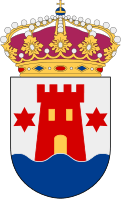Kalmar Air Force Wing
Kalmar Air Force Wing (Swedish: Kalmar flygflottilj), also F 12 Kalmar, or simply F 12, is a former Swedish Air Force wing with the main base located on the south-east coast of Sweden.
| Kalmar Air Force Wing | |
|---|---|
| Kalmar flygflottilj | |
 | |
| Active | 1942–1980 |
| Country | Sweden |
| Allegiance | Swedish Armed Forces |
| Branch | Swedish Air Force |
| Type | Wing (1940–1957) Sector wing (1957–1978) Wing (1978–1980) |
| Role | Fighter wing |
| Part of | First Air Group (1942–1948) Second Air Group (1948–1966) Southern Military District (1966–1980) |
| Garrison/HQ | Kalmar |
| March | "Kalmar flygflottiljs marsch" (Hartog)[note 1] |
| Insignia | |
| Roundel |  |
| Aircraft flown | |
| Bomber | B 4, B 5, B 17C |
| Fighter | J 21A, J 21B, J 29A, J 32B, J 35F |
| Reconnaissance | 14 |
| Trainer | Sk 12, Sk 14, Sk 15, Sk 16 Sk 50 |
| G 101, S 102, Se 103, Se 104, P 1 | |
History
The wing started out with three squadrons of B 17C in 1942.
In 1947, F 12 was converted to a fighter wing by replacing the light bombers with the J 21A-2 which were upgraded to -3 before they were obsolete.
Through 1952 to 1953, the three wings replaced the J 21's with J 29As which were only kept for five years until they were replaced by the J 32B Lansen in 1958. However, one of the squadrons were decommissioned after only two years.
In 1962, the Air Force Meteorology School moved to F 12 Kalmar from F 2 Hägernäs.
The two squadrons were upgraded to J 35F in 1968 which were kept until the decommissioning of the wing in 1980.
The base with the meteorology school continued to operate under the F 17K name as a detachment to Blekinge Air Force Wing (F 17) until 1983 when the school moved to the Swedish Air Force Flying School.
The airfield has been used for general and commercial aviation as Kalmar Airport (IATA: KLR, ICAO: ESMQ) since 1980.
Heraldry and traditions
Coat of arms
Blazon: "Argent, the town badge of Kalmar, from a waved base azure a tower embattled gules, gate and window or issuant between two etoiles gules."[2]
Colours, standards and guidons
A colour was presented to the wing on 17 September 1944 at F 8 in Barkarby by His Majesty the King Gustaf V.[3] The colour is preserved at Blekinge Air Force Wing. Blazon: "On blue cloth in the centre the badge of the Air Force; a winged two-bladed propeller under a royal crown proper. In the first corner from a waved base a yellow tower embattled issuant between two mullets".[3]
 Colour
Colour Colour with staff
Colour with staff
March
”Kalmar flygflottiljs marsch” was composed by Bo Hartog, the wing's music director. It has not been officially established.[3]
Commanding officers
Commanding officers from 1942 to 1980.[4] The commanding officer was referred to as flottiljchef ("wing commander") and had the rank of colonel. From 1976 to 1978, the wing commander was referred to as sektorflottiljchef ("sector wing commander"). The deputy sector wing commander was sometimes referred to as wing commander.
- 1942–1954: Ragnar Carlgren
- 1954–1966: Thomas Stålhandske
- 1966–1970: Gunnar Rissler
- 1970–1972: Carl-Gustaf Simmons
- 1972–1980: Fritz Crona
Names, designations and locations
| Name | Translation | From | To | |
|---|---|---|---|---|
| Kungl. Kalmar flygflottilj | Royal Kalmar Air Force Wing | 1942-07-01 | – | 1974-12-31 |
| Jämtlands flygflottilj | Kalmar Air Force Wing | 1975-01-01 | – | 1980-06-30 |
| Designation | From | To | ||
| F 12 | 1942-07-01 | – | 1957-09-30 | |
| F 12/Se S2 | 1957-10-01 | – | 1978-??-?? | |
| F 12 | 1978-??-?? | – | 1980-06-30 | |
| Location | From | To | ||
| Törneby | 1942-07-01 | – | 1980-06-30 | |
| Kalmar Airport | 1942-07-01 | – | 1980-06-30 |
Footnotes
- The march was never officially established for the wing.[1]
References
Notes
- Sandberg 2007, p. 37
- Braunstein 2006, p. 60
- Braunstein 2005, p. 87
- Braunstein 2005, p. 88
Print
- Braunstein, Christian (2005). Svenska flygvapnets förband och skolor under 1900-talet (PDF). Skrift / Statens försvarshistoriska museer, 1101-7023 ; 8 [dvs 9] (in Swedish). Stockholm: Statens försvarshistoriska museer. ISBN 9197158488. SELIBR 9845891.CS1 maint: ref=harv (link)
- Braunstein, Christian (2006). Heraldiska vapen inom det svenska försvaret [Heraldry of the Swedish Armed Forces] (PDF). Skrift / Statens försvarshistoriska museer, 1101-7023 ; 9 (in Swedish). Stockholm: Statens försvarshistoriska museer. ISBN 91-971584-9-6. SELIBR 10099224.CS1 maint: ref=harv (link)
- Sandberg, Bo (2007). Försvarets marscher och signaler förr och nu: marscher antagna av svenska militära förband, skolor och staber samt igenkännings-, tjänstgörings- och exercissignaler (in Swedish) (New ed.). Stockholm: Militärmusiksamfundet med Svenskt marscharkiv. ISBN 978-91-631-8699-8. SELIBR 10413065.CS1 maint: ref=harv (link)
Further reading
| Wikimedia Commons has media related to Kalmar Air Force Wing. |
- Norrbohm, Gösta; Skogsberg, Bertil (1980). Vingar över Vasaborgen: Kungl Kalmar flygflottilj F12 1942-1980 (in Swedish). Mjölby: BM-förl. ISBN 91-7260-433-6. SELIBR 7629104.